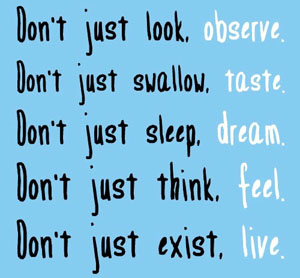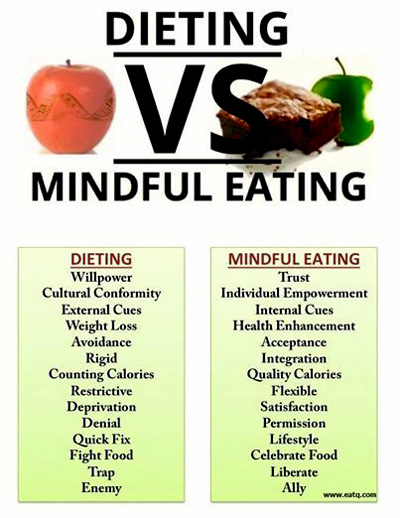Eat With Your Mind
“The path to healthy body, and happy soul is based upon self-study, mindfulness, love and awareness. Understanding our relationship to eating cultivates a lot of insights…”
– Natasa Pantovic Nuit, Mindful Eating
Our world is fast, growing faster. This pace effects many aspects of our wellness, even our eating. We’ve talked over time about  what we eat in the Fat Guy’s Guide to Health section of the site. This article is devoted to not what, but how we eat.
what we eat in the Fat Guy’s Guide to Health section of the site. This article is devoted to not what, but how we eat.
According to registered dietician Stephanie Vangsness, “meals have become yet another task we squeeze in during the day. It is all too common to hear of people grabbing breakfast on the run or attending a lunch meeting, where business is front and center and food is merely the bait to get people there” (2016). This leads to a pattern of “Mindless Eating”—eating with our attention on something other than the act of eating—which is the cause of millions of American pounds every year. Mindless eating is not just rampant in our boardrooms. It’s in our schools, with some statistics saying that the allotted average time a child has to eat lunch is 7-11 minutes. It’s in our homes at an epidemic level with the majority of Americans eating at least one full meal or multiple snacks while watching a screen.
“It turns out that when our mind is tuned out during mealtime, the digestive process may be 30% to 40% less effective. This can contribute to digestive distress, such as gas, bloating and bowel irregularities” Vangsness noted, but “overeating and obesity are perhaps the most significant health problems caused, at least in part, by mindless eating.”
Mindfully Full
“When walking, walk. When eating, eat.”
– Zen Proverb
Excitingly enough, the solution is to…enjoy ourselves! And to be satisfied! We’re still learning about the “mind-body connection” in eating and digestion, but we do know that focusing our mind on it “plays a pivotal role in our ability to accurately assess hunger and fullness.” Which means that “eating while multitasking, whether working through lunch or watching TV while eating dinner, often leads us to eat more.”
This is because “if the mind is multi-tasking during eating, critical signals that regulate food intake may not be received by the brain. If the brain does not receive certain messages that occur during eating, such as sensation of taste and satisfaction, it may fail to register the event as eating” (Vangsness, 2016). We’ve all had that feeling of not even having a moment to think, let alone eat, and we dash from our desks to the next task without feeling the food hit bottom. In such hectic days, it’s such a missed opportunity for pause, reflection and pleasure that would almost certainly increase productivity afterward by boosting our mood. We miss a similar chance at double the pleasure when we spend the time to make a great meal only to miss out on the full experience in front of the TV.
“On the other hand,” Vangsness (2016) and mindfulness experts encourage “eating mindfully, savoring every mouthful, enhances the experience of eating and keeps us aware of how much we take in….Mindful eating is being present, moment by moment, for each sensation that happens during eating.”
Fully Mindful
“Better to eat a dry crust of bread with peace of mind than have a banquet in a house full of trouble.”
– Proverbs 17:1
We’ve looked at Mindfulness as a Street Level Wellness practice in Your Inner Indiana Jones where it was described as “…paying attention to your life, here and now, with kindness and curiosity,” by researcher and Mindfulness practitioner Dr. Amy Saltzman (2010) who also noted “there are many definitions of mindfulness” and it can be employed in many areas of our lives.
In terms of eating, the ethos above is carefully applied to one small food item or one bite of food as we relish it. It is important to remember that mindfulness is a skill to be built and an exercise like this is like any type of physical exercise—a focused activity to increase an ability, in this case food awareness.
Below is a script that can be generally applied to a single piece of food, a forkful or a meal. It was originally written by Mark Williams, John Teasdale, Zindel Segal, and Jon Kabat-Zinn (2007) with the focus on one single raisin. Feel free to check the link to see the full script or apply these prompts in order, with your own item.
Holding – “…hold it…Focusing on it, imagine that you’ve just dropped in from Mars and have never seen an object like this before in your life.”
Seeing – “Take time to really see it…”
Touching – This one can be optional depending on the item. The authors encourage that, if possible to do so “with your eyes closed if that enhances your sense of touch.”
Smelling – Inhale with attention not just on the food, “noticing as you do this anything interesting that may be happening in your mouth or stomach.”
Placing – “Spend a few moments exploring the sensations of having it in your mouth.”
Tasting – “Without swallowing yet, notice the bare sensations of taste and texture in the mouth and how these may change over time, moment by moment, as well as any changes in the object itself.”
Swallowing – Yes, even this can be mindful and self-focused to “see if you can first detect the intention to swallow as it comes up…” and be present with that desire.
Following – “Finally, see if you can feel what is left…moving down into your stomach, and sense how the body as a whole is feeling after completing this exercise in mindful eating.”
Pretty intense for just one bite? Practitioners note that a whole meal isn’t to be eaten this way. It is either a single item exercise or something that can be done at the table with the first bite, as a reminder to focus, or throughout a meal to re-focus. Vangsness (2016) also offers some simpler techniques to get us started like “Eat with chopsticks, or with your non-dominant hand, chew your food 30 to 50 times per bite, eat without TV, newspaper or computer,” and perhaps the most indicting of our hurried lifestyle, the simple change of “eat sitting down.”
With eating, as with life, we are seeking pleasure, satisfaction and peace. Mindful eating is a way to increase that with every meal, one bite at a time.
___________________________________________________
Saltzman, Amy PhD. (2010) Mindfulness: A Teacher’s Guide. ContemplativeMind.org retrieved from http://www.pbs.org/thebuddha/teachers-guide/
Vangsness, S. (2016) Mastering the Mindful Meal. Brigham and Women’s Hospital. Retrieved from: http://www.brighamandwomens.org/patients_visitors/pcs/nutrition/services/healtheweightforwomen/special_topics/intelihealth0405.aspx
Williams, M., Teasdale, J., Segal, Z., & Kabat-Zinn, J. (2007) The Mindful Way through Depression: Freeing yourself from chronic unhappiness. New York: Guilford Press. Retrieved from: http://hfhc.ext.wvu.edu/r/download/114469



